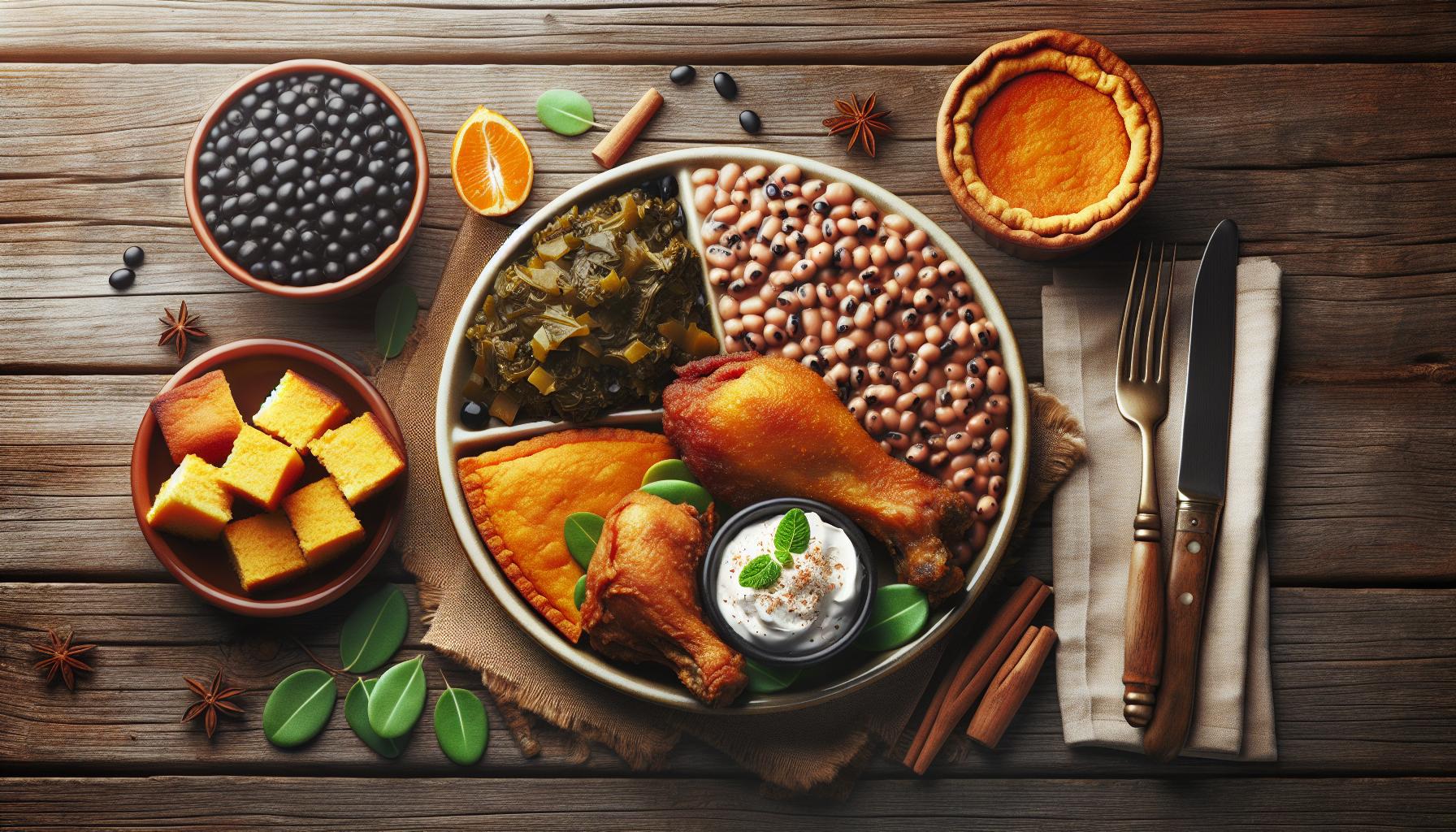Physical Address
304 North Cardinal St.
Dorchester Center, MA 02124

African American cuisine stands as a vibrant testament to resilience creativity and cultural heritage. From soul-warming comfort foods to innovative fusion dishes this culinary tradition has shaped America’s food landscape for generations. What began as a necessity during times of hardship has evolved into a celebrated cornerstone of American gastronomy.
The story of African American food culture is deeply intertwined with history survival and community. Soul food emerged from the kitchens of enslaved people who transformed humble ingredients into flavorful masterpieces. Today these time-honored recipes continue to bring families together while inspiring modern chefs to explore new culinary horizons. It’s a cuisine that proves the old saying true – necessity really is the mother of invention and in this case it’s absolutely delicious.
African American food culture emerged from a complex blend of West African traditions, survival strategies during slavery, and regional American ingredients. The culinary practices evolved through generations of oral tradition and resourceful adaptation.
West African cooking techniques form the foundation of African American cuisine. Rice cultivation methods from Senegal and Ghana shaped the development of Carolina Gold rice in South Carolina’s Lowcountry. Traditional ingredients like okra, black-eyed peas, yams, and leafy greens remain staples in modern African American kitchens. Cooking methods such as one-pot stewing, frying in hot oil, and slow-cooking meats originated from West African practices. The use of spices like red pepper, traditional in West African cuisine, influenced the distinctive flavoring profiles found in soul food dishes.
Enslaved Africans transformed limited food rations into nourishing meals through innovative cooking methods. Their resourcefulness led to signature dishes like chitlins, cornbread, and collard greens. Garden plots near slave quarters produced vegetables that supplemented basic provisions. The practice of eating field peas, sweet potatoes, and salt pork emerged from the restrictions of plantation life. Communal cooking practices in slave quarters preserved African traditions while creating new culinary techniques. The Sunday dinner tradition originated during this period as a rare opportunity for families to gather and share meals.
| Traditional West African Ingredients | Adaptation in American South |
|---|---|
| Yams | Sweet Potatoes |
| Palm Oil | Pork Fat |
| Rice | Carolina Gold Rice |
| Sorghum | Cornmeal |
| Groundnuts | Black-eyed Peas |

Soul food represents the cornerstone of African American culinary traditions, embodying generations of cultural heritage through distinctive flavors and cooking techniques. This cuisine celebrates the resourcefulness of African American communities who transformed humble ingredients into memorable dishes.
Soul food recipes center on a core set of ingredients that reflect both African heritage and American agricultural traditions. Leafy greens like collards mustard greens form the foundation of many dishes. Black-eyed peas beans bring protein nutrition to classic recipes. Cornmeal appears in staples like cornbread hoecakes. Root vegetables such as sweet potatoes yams feature prominently in both savory dishes desserts. Smoked meats including ham hocks salt pork add depth to vegetable dishes. Fresh okra serves as both a thickener flavoring agent in soups stews. Rice accompanies many meals reflecting West African culinary influences.
African American cooking techniques emphasize slow cooking methods that extract maximum flavor from ingredients. Braising tough cuts of meat in cast iron pots creates tender flavorful results. One-pot cooking combines vegetables meats seasonings to develop rich broths. Hot water cornbread requires skilled hand mixing precise temperature control. Smoking preserves meat while adding distinctive flavors to dishes like country ham. Seasoning cast iron cookware builds layers of flavor over time. Deep frying in seasoned oils produces crispy textures in dishes like chicken fish. These methods often involve cooking at low temperatures for extended periods allowing flavors to meld develop complexity.
African American cuisine displays distinct regional characteristics across the United States, with each area contributing unique flavors and cooking methods to the culinary landscape. These variations reflect local ingredients, historical settlement patterns and environmental influences.
Southern soul food represents the heart of African American cuisine, centered in states like Georgia, Alabama and Mississippi. Classic dishes include crispy fried chicken, smoky collard greens seasoned with ham hocks and creamy mac and cheese. The Carolinas contribute distinct barbecue traditions, featuring pulled pork with vinegar-based sauces. Louisiana adds Creole influences through dishes like gumbo, jambalaya and red beans with rice. Essential cooking techniques involve slow-simmering vegetables, smoking meats and perfecting cornbread in cast-iron skillets. Local ingredients like sweet potatoes, okra and field peas feature prominently in traditional recipes.
Gullah Geechee cuisine thrives along the coastal regions from North Carolina to Florida, particularly in the Sea Islands. This distinctive cooking style maintains direct links to West African heritage through rice-based dishes like purloo and red rice. Fresh seafood forms the foundation of signature meals, including shrimp and grits, crab rice and oyster roasts. Local vegetables like sea island red peas and carolina gold rice preserve historical crop varieties. The cuisine emphasizes one-pot cooking methods and fresh-caught seafood preparations. Seasonings feature African-influenced spice blends incorporating hot peppers, bay leaves and seafood seasonings.
African American food culture serves as a cornerstone of family unity and cultural preservation. These culinary traditions create lasting bonds across generations through shared meals and preserved recipes.
Sunday dinners represent a sacred tradition in African American households, with extended families gathering after church services to share meals. These weekly feasts feature signature dishes like fried chicken, macaroni and cheese, collard greens, cornbread, and sweet potato pie. Major holidays amplify these gatherings with specialized dishes: Thanksgiving tables showcase turkey with cornbread dressing, Christmas celebrations feature glazed ham, and New Year’s Day meals include black-eyed peas for luck. The dining room table transforms into a central hub where multiple generations exchange stories, celebrate milestones, and strengthen family bonds through shared meals.
Recipe preservation in African American families occurs through hands-on kitchen experiences where elders teach younger family members traditional cooking techniques. Grandmothers pass down unwritten recipes through oral instruction, demonstrating precise measurements like “a pinch” or “until it looks right.” Family cookbooks contain handwritten notes, documenting generations of modifications to original recipes. Modern technology enables families to record video tutorials of elders preparing traditional dishes, capturing their techniques for future generations. Social media platforms create virtual spaces where families share recipes across geographic boundaries, maintaining cultural connections through food traditions — often enhanced with background music produced by an AI music generator to make the content more engaging.
African American cuisine continues to evolve through innovative culinary techniques and health-conscious adaptations. Contemporary chefs honor traditional flavors while introducing modern elements that reflect today’s diverse food landscape.
Leading Black chefs transform classic soul food dishes into refined culinary experiences across the United States. Marcus Samuelsson’s Red Rooster in Harlem elevates traditional dishes with global influences, incorporating Ethiopian spices into classic Southern recipes. Edouardo Jordan earned two James Beard Awards for his restaurants in Seattle, where he combines African American cooking heritage with Pacific Northwest ingredients. Mashama Bailey at The Grey in Savannah reimagines coastal Southern cuisine through a modern lens, earning a Michelin star. These chefs create new flavor combinations while preserving traditional cooking techniques: smoking, braising, fermentation.
Modern interpretations of soul food focus on nutritious ingredients without sacrificing flavor profiles. Chefs incorporate plant based proteins like tempeh or jackfruit in place of traditional smoked meats. Traditional cooking methods adapt to healthier techniques: air frying replaces deep frying, smoked turkey substitutes for pork in greens, Greek yogurt creates lighter versions of mac and cheese. Plant forward soul food restaurants embrace collard greens, black eyed peas, sweet potatoes in their natural preparation. Celebrity chef Bryant Terry promotes vegan soul food through cookbooks featuring fresh ingredients. These adaptations maintain cultural connections while addressing contemporary health priorities.
African American cuisine stands as a cornerstone of American culinary heritage, influencing food culture across the nation. The impact extends beyond recipes to shape social gatherings, cooking techniques, and restaurant trends throughout the United States.
African American cooking techniques transformed the American food landscape through innovative flavor combinations and cooking methods. Dishes like fried chicken, barbecue, and mac and cheese evolved from African American kitchens to become staples of American cuisine. Notable contributions include the introduction of spice blends, smoking techniques, and slow-cooking methods that enhanced flavor profiles across regional cuisines. Many traditional African American ingredients, such as okra, black-eyed peas, and collard greens, integrated into mainstream American cooking. Top restaurants across the country feature soul food-inspired dishes on their menus, demonstrating the cuisine’s influence on fine dining.
Family recipes pass from generation to generation through hands-on cooking experiences in African American households. Elders teach specific techniques for seasoning cast iron skillets, preparing greens, and mastering perfect cornbread. Digital platforms enable wider sharing of traditional recipes through social media, food blogs, and video tutorials. Community cookbooks document local variations of classic dishes, preserving regional cooking styles. Cultural institutions like the National Museum of African American History and Culture maintain extensive collections of historical recipes, cooking utensils, and food-related artifacts. African American food festivals celebrate this culinary heritage in cities nationwide, featuring demonstrations by traditional cooks alongside contemporary chefs.
African American food culture stands as a testament to resilience creativity and innovation. From its roots in West African traditions to its evolution through challenging times this cuisine has become an integral part of America’s culinary identity.
Today’s African American chefs and home cooks continue to honor these time-tested traditions while adapting them for modern palates and health considerations. Through family gatherings community celebrations and culinary innovation these food traditions remain vibrant and evolving.
The legacy of African American cuisine extends far beyond the dinner table serving as a powerful reminder of how food can preserve history build community and shape cultural identity for generations to come.